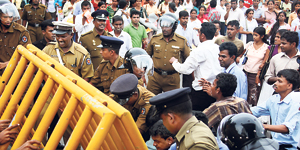
While Sri Lanka heads towards an ageing population what is most disturbing though, is that the remaining young people are getting older without contributing to national development. Picture shows a demonstration by unemployed graduates. |
|
Sri Lanka is heading towards an ageing population but the country has still not worked out what to do with its existing young people.
This week, the Employers Federation of Ceylon (EFC) and the International Labour Organisation (ILO) organised a workshop to see how businesses could help to reduce youth unemployment in the country. About a quarter of the country’s population are ‘youths’, based on the local definition of youth as the age group of 15 – 29 years. But this proportion is steadily shrinking in Sri Lanka. What is most disturbing though, is that many young people are getting older without contributing to national development.
Given the potential of young people to contribute to development, in December 2006, the Cabinet approved a Youth Employment National Action Plan. One of its targets is to reduce unemployment among young people to 15% by 2010 and to 8% by 2015. Youth unemployment was around 20% in 2007. The action plan was developed under the UN’s global Youth Employment Network (YEN) project which is supported by the ILO and the World Bank. But while another International Youth Day, came and went on August 12, the national action plan is still pretty much out of action.
“The action plan cannot be implemented islandwide straightaway. The ILO will do baseline surveys in the Sabaragamuwa province, to start with,” said the Secretary to the Ministry of Youth Affairs, S Wirithamulla. The Ministry says it is doing various other programmes to address youth unemployment in the meantime.“We have started a small enterprise development programme for young people where we pick young entrepreneurs and give them training and other types of assistance. The Youth Corps has a programme to address school dropouts. We also started a programme, to select young people and enhance their employability. We have other programmes also aimed at young people,” said Mr Wirithamulla. But the youth unemployment problem is only getting older, like Sri Lanka’s young people.
Young and the jobless
Around 150,000 young people with different levels of education enter the labour market every year, but most cannot find jobs. According to 2008 data, nearly half of the unemployed in Sri Lanka, 41%, are young people between the ages of 15 – 24 years. Also, despite the public spending on education, unemployment seems to increase with education in Sri Lanka.
“Unemployment among those with qualifications below the Ordinary Levels (O/Ls) is about 3.2%. Unemployment among O/L holders is about 6.4%. But unemployment among young people with Advanced Level qualifications and above, is 11%,” said the Field Programme Coordinator of the Youth Employment Programme of ILO Japan, Deepthi Lamahewa, speaking at the ILO-EFC workshop.
Meanwhile, unemployed university graduates staged demonstrations in Colombo again this week, demanding jobs.
Educated women at home
Young women are the worst off with unemployment double (28.4%) that of men (14.9%) in the 15 – 24 age group. Often women are also paid less than men for the same work.“In areas like construction and in agriculture, except for reaping the harvest, women are paid less than men for doing the same work,” said the head of the Sociology Department at the Colombo University, Dr Subangi Herath. The experts point out that in addition lower returns for the public spending on educating girls, unemployment and underpayment of women also has other, longer term, impacts. For instance, a malnourished future generation.“Malnutrition in children is directly related to poor incomes and poor education of women. So it is not only about employment for women,” said Dr Herath.
Young aspirations
Local companies say young people prefer government jobs, even when the salaries are better in the private sector. For instance, the government and private sector partnership programme, Tharuna Aruna, tried to place young university degree holders in companies. The programme didn’t work as well as expected. “The moment the government offered jobs, they left. Government salaries were starting at around Rs 6,000. We were paying around Rs 20,000 and we had also invested a lot in these people,” said the Human Resources Director at Aitken Spence, Rohan Pandithakoralage.
But the experts say employment choices of young people are not based only on obvious benefits like higher salaries and job security.“One thing we can see from this whole Tharuna Aruna experience is that, young people are not interested only in the money. It is also not only about the pension and job security in government jobs either. Young people may feel that government jobs provide other opportunities,” said Mr Lamahewa. The Employers Federation says it is working on how businesses can help young people find the types of jobs they want or start their own businesses. But meanwhile, time is running out for Sri Lanka’s young people. . |
